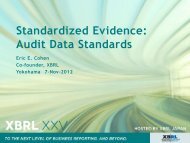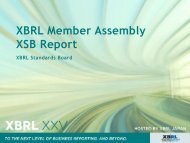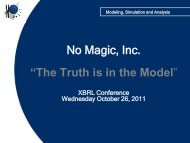UML Meta model for DPM
UML Meta model for DPM
UML Meta model for DPM
You also want an ePaper? Increase the reach of your titles
YUMPU automatically turns print PDFs into web optimized ePapers that Google loves.
<strong>UML</strong> <strong>Meta</strong> <strong>model</strong> <strong>for</strong> <strong>DPM</strong><br />
Katrin Heinze<br />
XBRL Expert at<br />
Deutsche Bundesbank
<strong>UML</strong> <strong>Meta</strong> <strong>model</strong> <strong>for</strong> <strong>DPM</strong><br />
Definition of a Data Point Model<br />
<strong>DPM</strong> is a dictionary of business concepts and their<br />
properties<br />
used in tables (explicitly indicated in annotation)<br />
identifying the content of every data point and<br />
its relation to other data points.<br />
Developed at:<br />
Data Point Model<br />
EIOPA<br />
EBA
<strong>UML</strong> <strong>Meta</strong> <strong>model</strong> <strong>for</strong> <strong>DPM</strong><br />
Example: Annotated COREP template <strong>for</strong> MKR SA EQU<br />
Data Point<br />
r30c10<br />
A Data Point as a financial concept is characterized by defining its basic financial<br />
meaning (nature) and specifying in<strong>for</strong>mation of breakdowns in which it is described<br />
in different tables or paragraphs of documentation.
<strong>UML</strong> <strong>Meta</strong> <strong>model</strong> <strong>for</strong> <strong>DPM</strong><br />
Process of Data Point Modelling
<strong>UML</strong> <strong>Meta</strong> <strong>model</strong> <strong>for</strong> <strong>DPM</strong><br />
Background <strong>for</strong> the development<br />
ambiguity in the understanding of the concept of a<br />
Data Point Model<br />
missing rule set to be followed in the process of<br />
Data Point <strong>model</strong>ling<br />
different constraints depending on the field of<br />
application<br />
missing abstraction layer to ease the understanding<br />
<strong>for</strong> IT experts<br />
missing description of the relations between the<br />
different components of a Data Point Model
<strong>UML</strong> <strong>Meta</strong> <strong>model</strong> <strong>for</strong> <strong>DPM</strong><br />
The Data Point <strong>Meta</strong> Model should provide<br />
(1) the <strong>model</strong> components <strong>for</strong> the creation of a<br />
<strong>for</strong>mal <strong>model</strong> on sets of data points <strong>for</strong> European<br />
supervisory reporting frameworks,<br />
(2) rules on how to combine these components and<br />
(3) the meaning (semantic) of the components and<br />
their relations.<br />
Similar to a <strong>model</strong> construction kit <strong>for</strong><br />
toys it provides the <strong>model</strong>ling principles<br />
with all characteristics available <strong>for</strong> use<br />
by the <strong>model</strong>ler.
<strong>UML</strong> <strong>Meta</strong> <strong>model</strong> <strong>for</strong> <strong>DPM</strong><br />
The different levels of<br />
meta <strong>model</strong>ling<br />
<strong>Meta</strong> meta<br />
<strong>model</strong><br />
defines notation<br />
<strong>Meta</strong><br />
<strong>model</strong>ling<br />
language<br />
con<strong>for</strong>ms to<br />
con<strong>for</strong>ms to<br />
<strong>Meta</strong><br />
<strong>model</strong><br />
defines notation<br />
Modelling<br />
language<br />
con<strong>for</strong>ms to<br />
Object<br />
system<br />
represented by<br />
Model<br />
system
<strong>UML</strong> <strong>Meta</strong> <strong>model</strong> <strong>for</strong> <strong>DPM</strong><br />
Decisions taken on the<br />
<strong>model</strong>ling approach <strong>for</strong><br />
the <strong>DPM</strong> <strong>Meta</strong> <strong>model</strong><br />
<strong>UML</strong> Model<br />
defines notation<br />
<strong>UML</strong><br />
con<strong>for</strong>ms to<br />
con<strong>for</strong>ms to<br />
Data Point<br />
<strong>Meta</strong><br />
<strong>model</strong><br />
defines notation<br />
<strong>UML</strong> + OCL<br />
con<strong>for</strong>ms to<br />
represented by<br />
Data Point Model<br />
OCL (Object Constraint Language)<br />
is a <strong>for</strong>mal language <strong>for</strong><br />
specifications. It refers to an <strong>UML</strong><br />
<strong>model</strong> to describe constraints<br />
about the objects in the <strong>model</strong>.
<strong>UML</strong> <strong>Meta</strong> <strong>model</strong> <strong>for</strong> <strong>DPM</strong><br />
Different perspectives on the meta <strong>model</strong><br />
Perspectives reduce the complexity and provide<br />
views on different aspects of the object system<br />
Perspectives needed to be consistent and<br />
complete as a whole<br />
Front view<br />
Side view<br />
<strong>model</strong>ling<br />
Top view<br />
Inconsistency<br />
Object system<br />
Model system
<strong>UML</strong> <strong>Meta</strong> <strong>model</strong> <strong>for</strong> <strong>DPM</strong><br />
Perspectives on the <strong>DPM</strong> <strong>Meta</strong> Model<br />
Structural<br />
Versioning<br />
Dimension Validation<br />
Hierarchical<br />
Presentation
<strong>UML</strong> <strong>Meta</strong> <strong>model</strong> <strong>for</strong> <strong>DPM</strong><br />
Definition of constraints<br />
General constraints on <strong>DPM</strong>s<br />
Data warehouse specific constraints<br />
European XBRL Taxonomy specific constraints
<strong>UML</strong> <strong>Meta</strong> <strong>model</strong> <strong>for</strong> <strong>DPM</strong><br />
The <strong>DPM</strong> <strong>Meta</strong> Model<br />
eases the understanding of <strong>DPM</strong>s <strong>for</strong> IT experts by<br />
using the standard <strong>model</strong>ling language <strong>UML</strong>,<br />
reduces the complexity of <strong>DPM</strong>s by showing only<br />
the relevant aspects,<br />
provides syntax and semantics to ease the<br />
automation of IT tasks<br />
like generating data <strong>for</strong>mats <strong>for</strong> the reporting<br />
process or<br />
validation checks on basis of the constraints<br />
defined,<br />
enables the derivation of a database design<br />
(relational as well as multidimensional).
Thanks <strong>for</strong> your attention<br />
katrin.heinze@bundesbank.de














